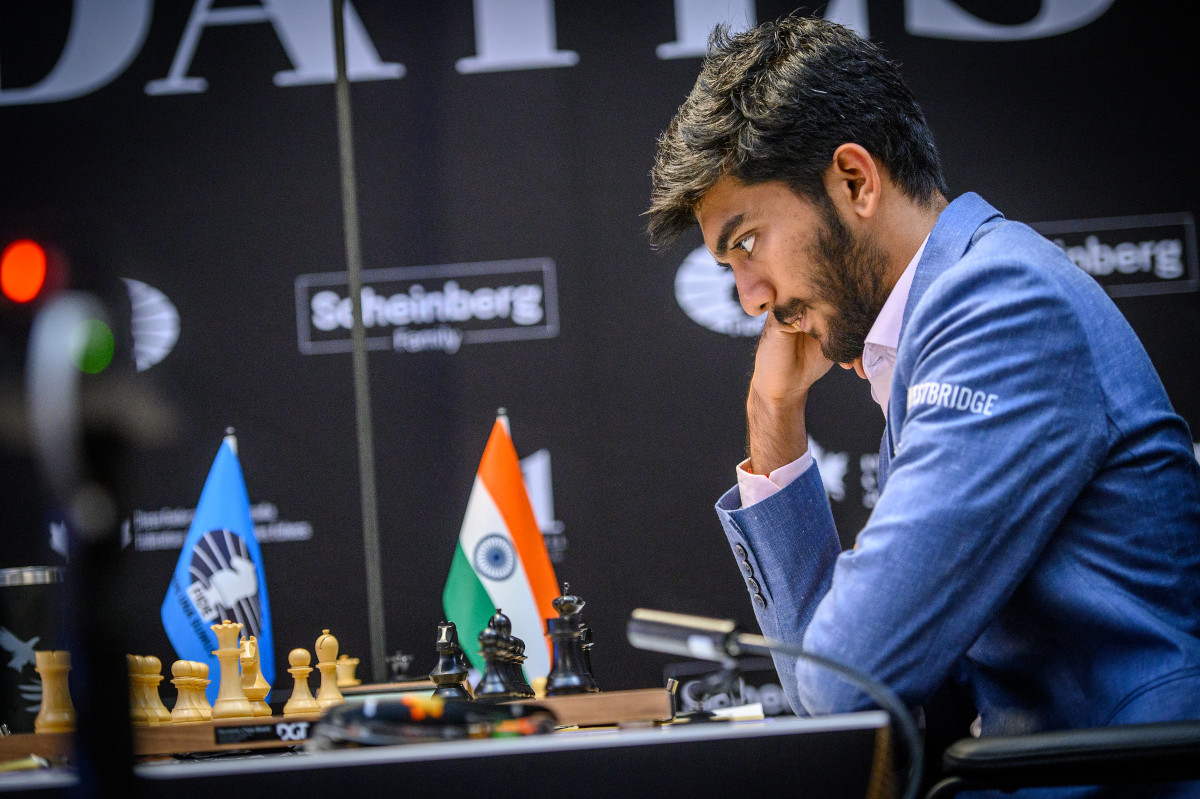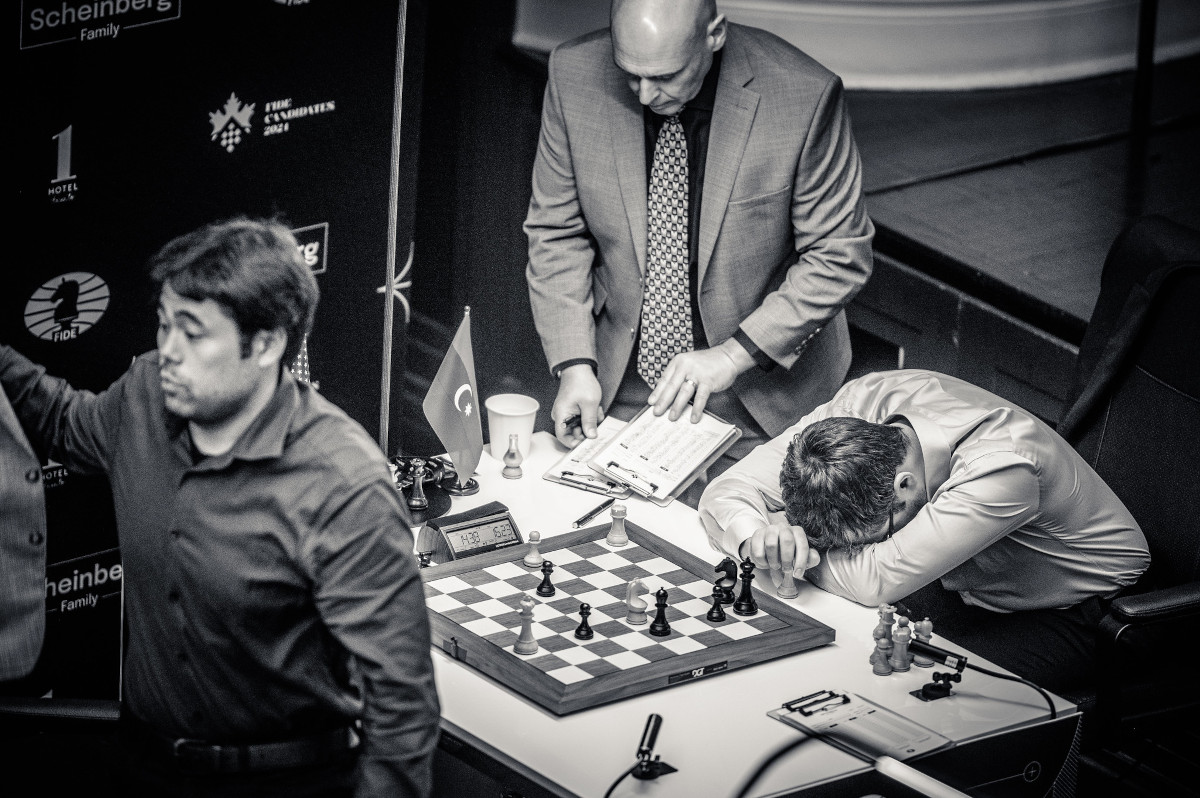.jpeg)

.jpeg)
ChessBase 17 - Mega package - Edition 2024
It is the program of choice for anyone who loves the game and wants to know more about it. Start your personal success story with ChessBase and enjoy the game even more.
With four rounds to go at the Candidates Tournament, four players stand within a 1-point distance from co-leaders Ian Nepomniachtchi and Gukesh D — i.e. six players have very realistic chances of emerging victorious by the end of the week.
In Monday’s round 10, Fabiano Caruana and Hikaru Nakamura, the top two seeds in Toronto, grabbed wins with white to join Praggnanandhaa R in shared third place, each with 5½ points (a half point behind the leaders). Nakamura defeated underdog Nijat Abasov, while Caruana beat Alireza Firouzja out of a double-edged Sicilian Najdorf.
Standing in sole sixth place is Vidit Gujrathi, who held a draw with black against Pragg after obtaining a remarkable victory over Nakamura on Sunday. Vidit has shown some of the most daring chess in the event, so he is surely capable of surmounting a 1-point deficit in the tournament’s final four rounds.
Meanwhile, Firouzja and Abasov are now out of the race for overall victory, with 3½ and 3 points respectively. Following the round-9 controversy regarding chief arbiter Aris Marghetis asking Firouzja to make less noise with his shoes, Firouzja’s father, Hamidreza Firouzja, talked to chess.com’s Mike Klein, this time complaining about organizers escorting him out of the playing hall. The organizers later explained that all family members are only allowed to watch the games live during the first 15 minutes of the round.
Results - Round 10
Attack like a Super Grandmaster
In this Fritztrainer: “Attack like a Super GM†with Gukesh we touch upon all aspects of his play, with special emphasis on how you can become a better attacking player.

In the clash of co-leaders, Dommaraju Gukesh held Ian Nepomniachtchi to a draw with the black pieces | Photo: FIDE / Michal Walusza
Top seed Caruana suffered a painful loss against Nakamura on Saturday, then kept things under control against Abasov on Sunday, and visibly entered round 10 looking for winning chances against a struggling Firouzja. The U.S. grandmaster played the audacious line with 6.Rg1 out of a Sicilian Najdorf.
This rook manoeuvre can only be justified by an early kingside manoeuvre, as was seen in this game. Firouzja welcomed the double-edged fight, creating a convoluted battle with chances for both sides in the early middlegame.
Amid the complications, though, Firouzja faltered with 13...Be6 — but Caruana failed to find the refutation.
After spending 14 minutes, Caruana replied by 14.Be2, missing the chance to enter a clearly superior position with 14.Bxe6 fxe6 15.e5, a remarkable tactical idea!
Black here is forced to play 15...dxe5 (entering a strategic lost position with tripled pawns on the e-file) since 15...Nxe5 fails to 16.f4, breaking the pin alongside the h6-c1 diagonal and forcing Black to play 16...Bxg5 17.hxg5, when both black knights are under attack.
Despite this being a sharp tactical idea, it is rather surprising that a tactician as talented as Caruana missed it in his calculations.
The top seed in Toronto nonetheless kept the initiative in the ensuing battle, as Firouzja continued to look for counterplay — due to his situation in the tournament and the nature of the position.
By move 26, both contenders had less than 15 minutes on their clocks, which led to a number of imprecisions in a queenless position with rooks, bishops and knights still on the board.
Once the knights left the board, Caruana had an extra pawn in a simplified-yet-tricky position. A critical sequence was seen on moves 35-37.
After 35.Re6+, Firouzja replied by 35...Kf7, allowing White to threaten a discovered check with 36.Bc4. The king manoeuvre is not losing, and it is understandable that Firouzja attempted to bring the monarch closer to the passed pawn on the d-file, but 35...Kg7 was still the correct path to escape the check.
It was only in the 36th move, though, that Firouzja faltered decisively by playing 36...Rd8, as a delayed 36...Kg7 was the way to go. Unlike the Frenchman a move ago, Caruana did find the most precise king manoeuvre at this critical point — i.e. 37.Ke1
This subtle move gains an important tempo, bringing the king closer to the weak pawn on g2 while taking advantage of the fact that 37...Bxg2 fails due to the discovered check with 38.Re2+.
Firouzja finally understood that he needed to play 37...Kg7, but after 38.Kf2, White had consolidated his position by decisively improving the position of his king.
Navigating the Ruy Lopez Vol.1-3
The Ruy Lopez is one of the oldest openings which continues to enjoy high popularity from club level to the absolute world top. In this video series, American super GM Fabiano Caruana, talking to IM Oliver Reeh, presents a complete repertoire for White.
What a difference a few king manoeuvres can make! Caruana had no trouble converting this technical position into a crucial 47-move victory.

Alireza Firouzja knows that there is no way to save the position, Fabiano Caruana is probably only waiting for his opponent’s resignation | Photo: FIDE / Michal Walusza
Nakamura’s victory over Abasov was by no means a walk in the park, as the Azerbaijani GM showed good preparation to equalize (or even get a slight edge) with black in the opening. It was only after the underdog’s 36...Qe7 that the U.S. grandmaster got the upper hand.
In hindsight, it is clear why Black needed to offer a bishop trade with 36...Bc7 here. What is surprising is how quickly Abasov placed his queen on e7 — with five moves to go before reaching the time control, he had 18 minutes to Nakamura’s 7, and played the mistaken queen manoeuvre almost instantly.
The problem for Black is that after 37.Be5, playing 37...Bc7 is no longer possible due to 38.Rb7, pinning the bishop (in the previous move, Black would have been able to capture the bishop on h2 with check).
After 37...Qe6 — a second mistake in a row, since 37...h4 was stronger (though also left Black in an inferior position) — 38.Ng3 there is no way for Black to avoid losing an exchange.
Calculation Training - Sharpen Your Game!
In Calculation Training – Sharpen Your Game! a total of 73 examples have been selected, the vast majority containing multiple questions, and more than 160 questions of varying difficulty.
Notice how White has managed to greatly restrain Black’s position: the knight is pinned along the c2-h7 diagonal, the king cannot go either to the eighth file (due to the rook) or to h6 (due to the g5-pawn), and the rook is captive on e2.
Abasov tried 38...Rxe5 here, but could do nothing against Nakamura’s technical prowess in the ensuing queenless battle. Resignation came on move 58.

Chess can be brutal! | Photo: FIDE / Michal Walusza
The all-important clash of co-leaders ended drawn after 40 moves. IM Robert Ris analysed the game on his growing YouTube channel.
Master advanced Tactics and Calculations like a super Grandmaster
The Indian chess grandmaster Vidit Gujrathi with an ELO of over 2700 (June 2023) is one of the best 20 players in the world. For the first time, the sympathetic top player presents himself in a video course. Let a world-class player show you tactical moti
Watch tons of high-quality content on ChessBase India’s YouTube channel!